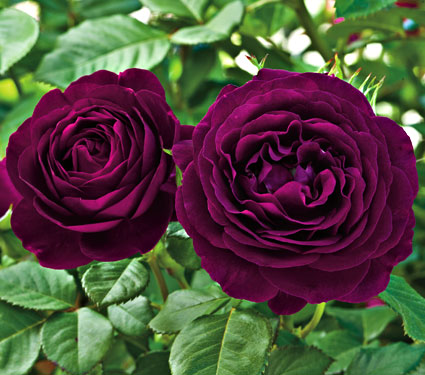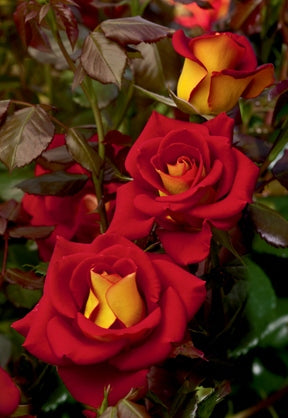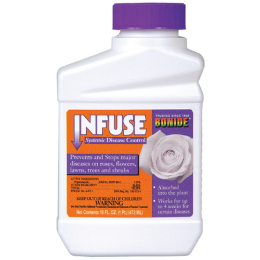March not only marks the start of spring, but the planting season begins with the arrival of roses at garden centers. Over 200 roses landed this week with the David Austin, shrub roses and many more ground varieties arriving within days. This is the time to add spring color to your landscape and it is easier than you might think.
Two exciting new introductions this year are fully rooted and already flushing new growth. Flower buds can almost be imagined on these healthy, full roses.
 The Twilight Zone – A perfect Grandiflora simply packed with petals in the traditional rose style. First, you will be fascinated with the unusual, deep amethyst color. Lean closer to admire the velvety, more than double blossoms that infuse the air with an intense fragrance of clove and lemony citrus flowers. Blooming in flushes all season, ‘The Twilight Zone’ is an ideal candidate for mixed perennial flower beds.
The Twilight Zone – A perfect Grandiflora simply packed with petals in the traditional rose style. First, you will be fascinated with the unusual, deep amethyst color. Lean closer to admire the velvety, more than double blossoms that infuse the air with an intense fragrance of clove and lemony citrus flowers. Blooming in flushes all season, ‘The Twilight Zone’ is an ideal candidate for mixed perennial flower beds.
Ketchup & Mustard – the catchy name takes one back to the ballpark, and definitely  describes the accenting colors on this rose. Bright red petals that are French’s mustard yellow underneath produce sumptuous color effects as the blossoms open. Clusters of striking, fragrant blooms appear in flushes all season on nearly thornless, bushy plants filled with glossy foliage. This rose is like eye candy in the landscape and even easier to grow with minimal care.
describes the accenting colors on this rose. Bright red petals that are French’s mustard yellow underneath produce sumptuous color effects as the blossoms open. Clusters of striking, fragrant blooms appear in flushes all season on nearly thornless, bushy plants filled with glossy foliage. This rose is like eye candy in the landscape and even easier to grow with minimal care.
March is the month to finish cutting the landscape back and the ideal month to prune roses. I realize pruning roses in March is unusual for gardeners from other areas, but the next few weeks are ideal for cutting back roses in the mountains. These bloomers can be thinned easily in five steps or less. So here we go!
Rose Step #1 – cut out all dead canes. Make sure you wear a good pair of gloves for this step. The dead thorns can really hurt. This gardener has a few battle scars, trust me. I highly recommend a good pair of rose gloves and any garden center should carry them.
Rose Step #2 – cut off wild looking canes and any crossing branches. Usually these wild-looking canes grow from below the graft, close to the ground. These canes are from the original rose root stock; you don’t want them on your bushes so cut them back to the graft. They are easily identified by the thorns that are heavier and sharper than the rest of the bush. Crossing branches are any that are growing across others, contradicting the overall shape of the bush.
Rose Step #3 – cut out old canes. These are canes that have bark starting to form on them and very thick, an inch or more in diameter. For this job I break out my favorite pair of long-handled pruners perfect for the job. These are specialty pruners you will only find at a garden center, but help you reach deep into the bush without being attacked. Cutting out these old canes will open up the bush and create the structure for the plant.
Rose Step #4 – prune out any canes that have suffered winter damage. These canes appear green on the bottom with a red to purple color on the tops that have been injured by frost. The goal is to end up with a bush that is knee to waist high and with 3 to 6 canes coming from the main graft near the ground with balanced spacing.
Rose Step #5 – seal any cut cane that is larger around than your pinkie finger. This will keep bugs from burrowing into the exposed soft wood. Look for black pruning paint that comes in a can with a small brush attached to the cap; it makes this job easy.
Now that your pruning is finished for another year, you should wind up your session with a little spring cleaning. Remove any dead leaves and flowers from around the graft so the air can circulate freely around the base of each plant. If you had problems with powdery mildew on certain bushes, make sure you pull all remaining leaves off the canes and really clean up thoroughly. This will reduce the possibility of mildew returning.
 Mildew was so bad last year, make sure not to miss this step. Spray the newly pruned rose with ‘Infuse’. This super concentrated liquid spray cleans the remaining bush of any powdery mildew, black spot and disease.
Mildew was so bad last year, make sure not to miss this step. Spray the newly pruned rose with ‘Infuse’. This super concentrated liquid spray cleans the remaining bush of any powdery mildew, black spot and disease.
Spring aphids are a potential threat, but with a good ‘Rose Food with a Systemic’ bug control this pest is eliminated. The plant actually absorbs the bug killer into the foliage to keeps bugs at bay. You’re done!

